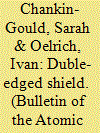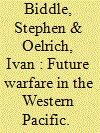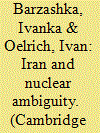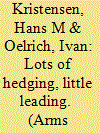|
|
|
Sort Order |
|
|
|
Items / Page
|
|
|
|
|
|
|
| Srl | Item |
| 1 |
ID:
061428


|
|
|
|
|
| Publication |
May-Jun 2005.
|
|
|
|
|
|
|
|
|
|
|
|
|
|
|
|
| 2 |
ID:
147045


|
|
|
|
|
| Summary/Abstract |
Many analysts worry that improvements in Chinese missile, sensor, guidance, and other technologies will enable China to deny the U.S. military access to parts of the Western Pacific that the United States has long controlled. Although these “antiaccess, area denial” (A2/AD) capabilities are real, they are a geographically limited long-term threat. As both the United States and China deploy A2/AD capabilities, a new era will emerge in which the U.S. military no longer enjoys today's command of the global commons, but is still able to deny China military hegemony in the Western Pacific. In this new era, the United States will possess a sphere of influence around allied landmasses; China will maintain a sphere of influence over its own mainland; and a contested battlespace will cover much of the South and East China Seas wherein neither power enjoys wartime freedom of surface or air movement. This in turn suggests that the Chinese A2/AD threat to U.S. allies is real but more limited than often supposed. With astute U.S. choices, most U.S. allies in this new system will be imperfectly, but substantially, secure.
|
|
|
|
|
|
|
|
|
|
|
|
|
|
|
|
| 3 |
ID:
111589


|
|
|
|
|
| Publication |
2012.
|
| Summary/Abstract |
A comparison between Iran's current nuclear efforts and those of the pro-Western regime of Shah Reza Pahlavi shows that Iranian ambitions for a full-fledged civilian nuclear programme have remained relatively constant for nearly half a century. Today, fuel cycle technology provides Iran with a latent nuclear weapon's potential. However, US concerns about an Iranian bomb, which began in the early 1970s and aggravated after the Iranian Revolution, long predate Teheran's uranium enrichment programme. Thus, Iran is a specific case of the general problem presented by the inherent potential of nuclear technology to both civilian and military ends. Approaches to dealing with a long-term, ambiguous, latent nuclear weapon threat, whether Iranian or other, are suggested.
|
|
|
|
|
|
|
|
|
|
|
|
|
|
|
|
| 4 |
ID:
089174


|
|
|
|
|
|
|
|